Abstract
In this report, we describe a case of brain abscess due to odontogenic infection. A 53-year-old female who had been suffering from headache and trismus for two weeks visited the Department of Oral and Maxillofacial Surgery at the Sun Dental Hospital (Daejeon, Korea). Even after several routine tests, we still could not make a diagnosis. However, after the combined multidisciplinary efforts of oral surgeons and neurosurgeons, the patient was treated for odontogenic infection and made an uneventful recovery. Therefore, patients with infections in the head and neck region showing symptoms such as headache, changes in mental state, nausea, vomiting, seizures, hemiplegia, speech disturbance, and visual disturbance, a brain abscess should be included in the list of differential diagnoses.
Keywords: Brain abscess, Odontogenic, Infection
I. Introduction
Untreated odontogenic infections can advance to osteomyelitis, cellulitis, myofascial space abscess, lymphadenitis, bacteremia, or sepsis, all of which can be extremely dangerous. Brain abscesses, which are rare, are also a potential type of infection that could arise. These are suppurative infections of the brain parenchyma that are surrounded by a vascularized capsule. In the United States, there are only 1,500 to 2,500 brain abscess cases each year1. Bacterial brain abscesses have three main etiologies. The most common cause is contiguous spread of infection from the oropharynx, middle ear, and paranasal sinuses2. Brain abscesses can also arise from hematogenous dissemination of bacteria3. Previous cranial trauma and neurosurgical procedures can also cause brain abscesses4,5,6.
The aim of this report is to present a rare case of a brain abscess due to odontogenic infection in a middle-aged woman.
II. Case Report
A 53-year-old female visited the Department of Oral and Maxillofacial Surgery at the Sun Dental Hospital (Daejeon, Korea) in September 2013 with trismus being her chief complaint. The patient had been receiving treatment for headaches and trismus at a local medical hospital and dental clinic for two weeks but the symptoms did not subside and the etiology was unclear. So the patient visited our clinic. At the time of her visit, the patient had facial swelling and trismus <20 mm. Routine clinical and radiologic exams showed localized chronic periodontitis of the maxillary right posterior region, but no other possible causes of the patient's symptoms (e.g., fascial space abscess) were found.(Figs. 1, 2) No systemic conditions that could have interfered with the patient's immune system were found.
Fig. 1.
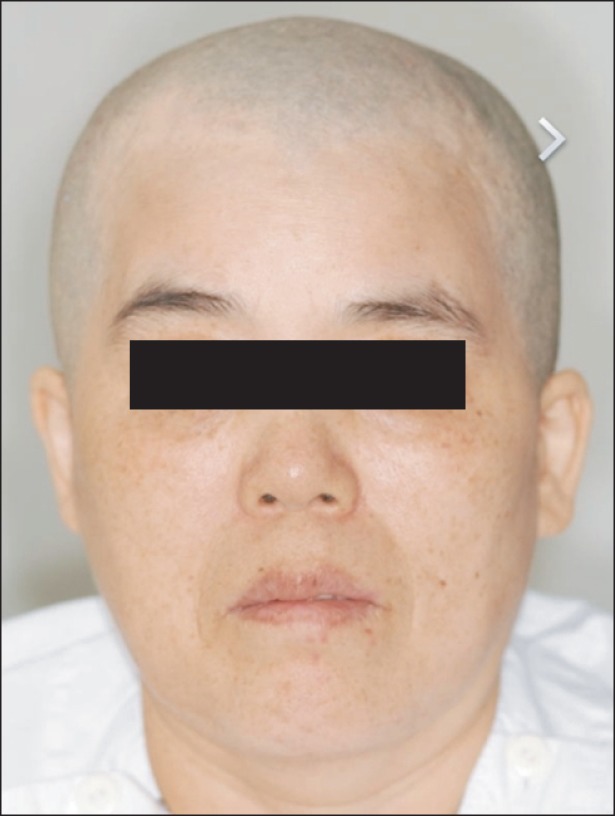
Photo shows preoperative facial characteristics on third day of hospitalization.
Fig. 2.
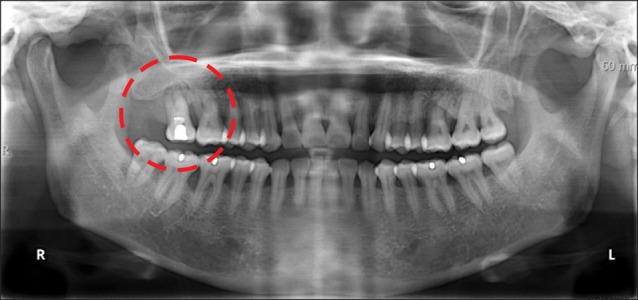
Panorex showed severe alveolar resorption of #17 (circle).
A pterygomandibular space abscess was first suspected to be the cause of trismus, but palpation and an aspiration exam yielded negative results. Meanwhile, laboratory blood tests revealed signs of an on-going infection. These results showed a white blood cell count of 12,900/mm3 with a differential count of 76.9% segmented cells and 16.5% lymphocytes. The erythrocyte sedimentation rate was 114 mm/hr and C-reactive protein level was 11.02 mg/dL. The patient's body temperature was 36.9℃. She also showed signs of myalgia, slightly altered orientation, and speech difficulty.
After her admission to the hospital, additional radiographs were taken.
On day one at the hospital, the patient had a 38.9℃ body temperature, which then rose to 39.3℃. She complained of a headache and soon became drowsy. Empirical antibiotics, such as augmentin, isepamicin, and metronidazole, were administered five days prior to her operation.
During imaging analyses, a 1.5×1.5 cm-sized perforation of the right sphenoid bone was detected (Fig. 3) and on magnetic resonance imaging (MRI) T2, a 1.3×1.8 cm-sized capsulated regular mass was observed in the right temporal lobe along with irregular edema.(Fig. 4) After consulting with neurosurgery specialists, the patient was diagnosed with a brain abscess of dental origin.
Fig. 3.

Computed tomography showed a perforation of the right sphenoid bone (arrows).
Fig. 4.
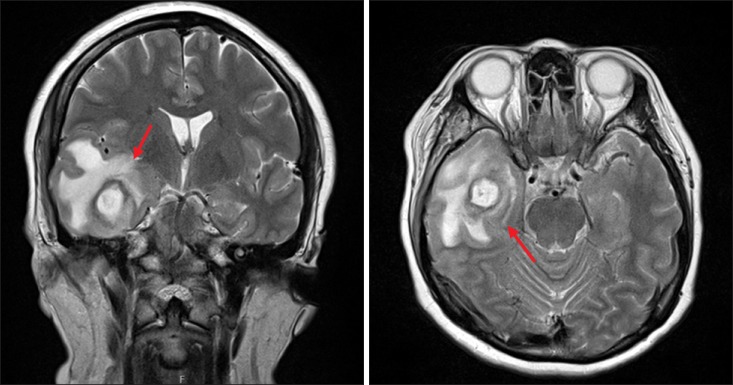
Magnetic resonance imaging T2 scan showed a 1.3×1.8 cm capsulated regular mass (arrows).
The patient then underwent abscess drainage through a craniotomy procedure, which involved decompressive craniotomy and aspiration without resection of the capsule while the patient was under general anesthesia. Approximately 8 mL of yellowish-brown pus was aspirated from the legion (Fig. 5) and a small amount of the pus was sent for culture. The capsule of the abscess was not removed because it had adhered to the brain parenchyma. The patient was put on postoperative intravenous antibiotic therapy, including ceftriaxone, Hanomycin (Sam Jin Pharm., Seoul, Korea), isepamicin and trizel. Antibiotics were administered intravenously until all symptoms subsided. After 48 hours, there was no bacterial growth from the pus culture. One week after undergoing decompressive craniotomy and aspiration, the patient's headache disappeared and her maximal mouth opening increased to about from 15 mm to 30 mm. The upper right second molar, which was suspected to be the source of the infection, was extracted while the patient was under local anesthesia.(Fig. 6) After the operation, the patient remained on antibiotics for two months. The patient remained under the care of an oral surgeon and a neurosurgeon and she recovered fully. She was discharged from the hospital without any neurological sequela.(Fig. 7)
Fig. 5.

Procedures of craniotomy and aspiration: approximately 8 mL of pus was removed.
Fig. 6.
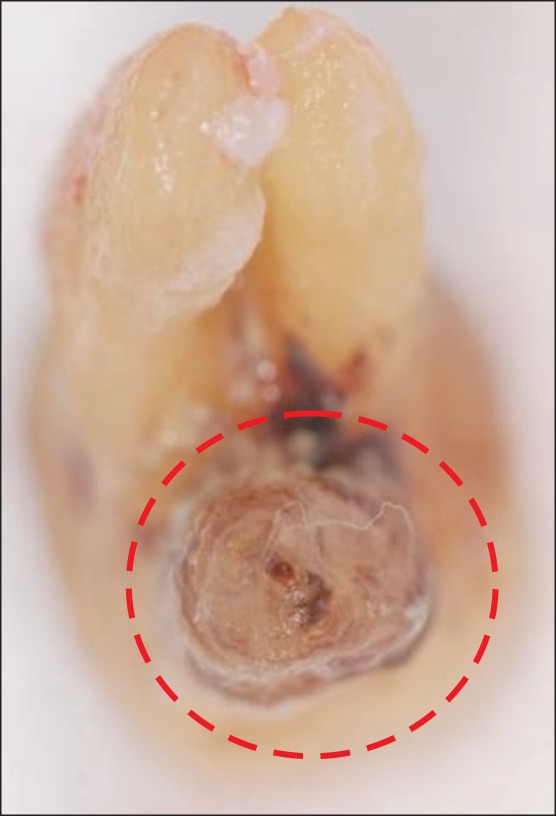
The extracted tooth had severe root resorption (circle).
Fig. 7.
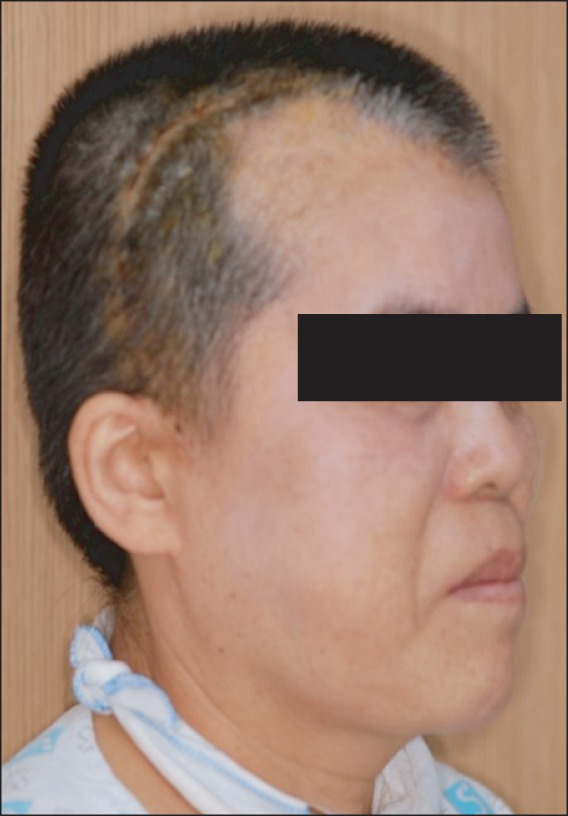
The patient did not show any signs of neurological sequela.
The total treatment process is described in Table 1.
Table 1.
Timetable showing the treatment process

(OM: oral medicine, IM: internal medicine, OMFS: oral and maxillofacial surgery, NS: neurosurgery, Tx: treatment, CT: computed tomography, MRI: magnetic resonance imaging, ADM: admission, Ext: extraction)
Table 2 shows the patient's lab results and body temperatures at different treatment stages.
Table 2.
Lab results and body temperature at different treatment stages

(HD: hospital day, Op.: operative, POD: postoperative date, WBC: white blood cell, ESR: erythrocyte sedimentation rate, CRP: C-reactive protein, BT: body temperature)
By seven months post-surgery, there had been no recurrence of the infection, as determined by computed tomography (CT) and MRI during follow-up appointments.(Fig. 8)
Fig. 8.

Comparing preoperative magnetic resonance imaging (MRI) with seven-month postoperative MRI is shown (arrows).
III. Discussion
Brain abscess is an extremely aggressive, life-threatening infection. It can have as its etiology a metastasis of chronic suppurative disease or congenital cardiomyopathy, or can arise after trauma like open-head injuries or after neurosurgical procedures. Sinusitis, otitis, and untreated odontogenic infections can also be a cause of brain abscess7. Corson et al.8 reported that cerebral abscesses, albeit rarely, can result from dental or maxillofacial infections.
A diagnosis of brain abscess is considered definite if bacterial organisms were isolated from abscess pus or cerfebral spinal fluid cultures. In this case, the CT scan showed findings characteristic of brain abscess, including the classical clinical manifestations of headache, fever, localized neurological signs, or disturbance of consciousness. In other patients, confirmation of abscess has come about upon the disappearance of CT abnormalities after antibiotic treatment.
Development and advancement of antibiotics, bacteriological culture and identification techniques, computed tomography, and magnetic resonance imaging have changed the prognosis dramatically1,9,10, which, in turn, has resulted in the mortality rate being reduced from 40%-60% in the pre-CT era to 0%-10% currently1.
The causative pathogens of brain abscesses vary with underlying medical or surgical conditions and the mode of infection11,12. Lu et al.12 reported 19 out of 123 patients with brain abscesses were culture-negative. Between 24%-40% of all intracerebral abscesses produce negative culture results because the patient has already received antimicrobial therapy12, which is the reason that we suspect there was no bacterial growth in this case.
There have been a few articles dealing with brain abscesses that have suspected odontogenic origin.
A PubMed search using the key words "brain abscess," "odontogenic," and "dental" yielded twenty-two articles, all of which were case reports. However, none of these reports described the relationship between brain abscess and dental infection because they lacked evidence to do so. In the case reported here, there was a clear progression route from infection in the right maxillary second molar to the right temporal lobe through the perforated sphenoid bone. Upon extracting the right maxillary second molar, severe palatal root resorption was observed.
In 2000, de Louvois et al.13 argued for a more thoughtful use of antibiotics for treating brain abscesses, emphasizing the ability of antibiotics to penetrate the blood-brain barrier. Sjölin et al.14 used third-generation cephalosporins, such as cefotaxime, ceftriaxone, and ceftazidime, as well as metronidazole, to treat patients with odontogenic intracranial infections. They recommended a combination of ampicillin, metronidazole, and either ceftazidime or gentamicin, for treating otogenic abscesses.
Gorgan et al.15 reported a general morbidity of 26.19% and mortality remained stable at 7.14% among a total of 84 patients over 12 years, from 2000 to 2011. Half of the patients in this series were diagnosed inaccurately at the initial stage, and it took an average of 7.2 days until the patients received the accurate diagnosis of brain abscess. Bibliographically, the average time between the onset of the symptoms and confirmed diagnoses was 9.6 days16.
In the case reported here, the patient was initially inaccurately diagnosed. It took 14 days to get an accurate diagnosis of a brain abscess. Successful treatment of brain abscesses requires early diagnosis, timely surgical intervention, and continuous high-dose antibiotic therapy.
Symptoms of brain abscess include headache, changes in mental state, nausea, vomiting, seizures, hemiplegia, speech disturbance, visual disturbance, and others. Therefore, in examining patients with infections in the head and neck region, if they display any of the above symptoms, brain abscess should be included in the differential diagnosis list. An immediate medical consultation to the neurosurgery department must follow when brain abscess is suspected.
Footnotes
No potential conflict of interest relevant to this article was reported.
References
- 1.Mamelak AN, Mampalam TJ, Obana WG, Rosenblum ML. Improved management of multiple brain abscesses: a combined surgical and medical approach. Neurosurgery. 1995;36:76–85. doi: 10.1227/00006123-199501000-00010. [DOI] [PubMed] [Google Scholar]
- 2.Mathisen GE, Johnson JP. Brain abscess. Clin Infect Dis. 1997;25:763–779. doi: 10.1086/515541. [DOI] [PubMed] [Google Scholar]
- 3.Heilpern KL, Lorber B. Focal intracranial infections. Infect Dis Clin North Am. 1996;10:879–898. doi: 10.1016/s0891-5520(05)70331-7. [DOI] [PubMed] [Google Scholar]
- 4.Xiao F, Tseng MY, Teng LJ, Tseng HM, Tsai JC. Brain abscess: clinical experience and analysis of prognostic factors. Surg Neurol. 2005;63:442–449. doi: 10.1016/j.surneu.2004.08.093. [DOI] [PubMed] [Google Scholar]
- 5.Tseng JH, Tseng MY. Brain abscess in 142 patients: factors influencing outcome and mortality. Surg Neurol. 2006;65:557–562. doi: 10.1016/j.surneu.2005.09.029. [DOI] [PubMed] [Google Scholar]
- 6.Tonon E, Scotton PG, Gallucci M, Vaglia A. Brain abscess: clinical aspects of 100 patients. Int J Infect Dis. 2006;10:103–109. doi: 10.1016/j.ijid.2005.04.003. [DOI] [PubMed] [Google Scholar]
- 7.Carpenter J, Stapleton S, Holliman R. Retrospective analysis of 49 cases of brain abscess and review of the literature. Eur J Clin Microbiol Infect Dis. 2007;26:1–11. doi: 10.1007/s10096-006-0236-6. [DOI] [PubMed] [Google Scholar]
- 8.Corson MA, Postlethwaite KP, Seymour RA. Are dental infections a cause of brain abscess? Case report and review of the literature. Oral Dis. 2001;7:61–65. [PubMed] [Google Scholar]
- 9.Petti CA, Simmon KE, Bender J, Blaschke A, Webster KA, Conneely MF, et al. Culture-Negative intracerebral abscesses in children and adolescents from Streptococcus anginosus group infection: a case series. Clin Infect Dis. 2008;46:1578–1580. doi: 10.1086/587655. [DOI] [PubMed] [Google Scholar]
- 10.Mamelak AN, Obana WG, Flaherty JF, Rosenblum ML. Nocardial brain abscess: treatment strategies and factors influencing outcome. Neurosurgery. 1994;35:622–631. doi: 10.1227/00006123-199410000-00007. [DOI] [PubMed] [Google Scholar]
- 11.Kao MC. Brain abscess. A clinical analysis of 26 cases with surgical treatment. Bull Tokyo Med Dent Univ. 1973;20:35–50. [PubMed] [Google Scholar]
- 12.Lu CH, Chang WN, Lin YC, Tsai NW, Liliang PC, Su TM, et al. Bacterial brain abscess: microbiological features, epidemiological trends and therapeutic outcomes. QJM. 2002;95:501–509. doi: 10.1093/qjmed/95.8.501. [DOI] [PubMed] [Google Scholar]
- 13.de Louvois J, Brown EM, Bayston R, Lees PD, Pople IK. The rational use of antibiotics in the treatment of brain abscess. Br J Neurosurg. 2000;14:525–530. doi: 10.1080/02688690020005527. [DOI] [PubMed] [Google Scholar]
- 14.Sjölin J, Lilja A, Eriksson N, Arneborn P, Cars O. Treatment of brain abscess with cefotaxime and metronidazole: prospective study on 15 consecutive patients. Clin Infect Dis. 1993;17:857–863. doi: 10.1093/clinids/17.5.857. [DOI] [PubMed] [Google Scholar]
- 15.Gorgan M, Neacsu A, Bucur N, Pruna V, Lipan C, Sandu AM, et al. Brain abscesses: management and outcome analysis in a series of 84 patients during 12 year period. Romanian Neurosurg. 2012;XIX 3:175–182. [Google Scholar]
- 16.Le Moal G, Landron C, Grollier G, Bataille B, Roblot F, Nassans P, et al. Characteristics of brain abscess with isolation of anaerobic bacteria. Scand J Infect Dis. 2003;35:318–321. doi: 10.1080/00365540310000265. [DOI] [PubMed] [Google Scholar]


